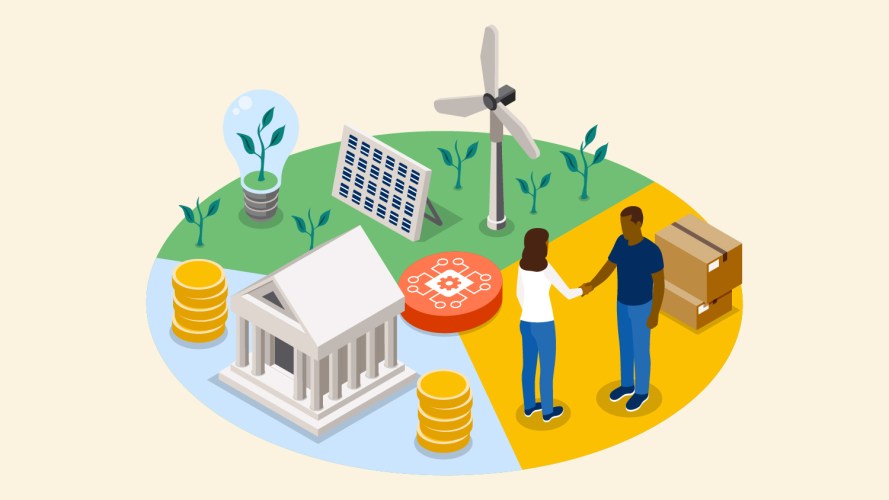Don’t Miss These 5 ESG Strategy Blind Spots

There’s so much more to an ESG strategy than just reporting. Making sure you’ve got all your bases covered can help both the environment and your bottom line.

Ken Cundari
As new environmental, social, and governance (ESG) regulations take shape around the world, businesses need to make sure their sustainability policies and efforts are up to snuff. Even if you think you’ve got ESG compliance covered, taking a more holistic view of your efforts can help you remain agile as regulations and stakeholder expectations shift.
Especially as more regulations call for a move from voluntary reporting into required disclosures audited by third parties, this is a perfect time to review your ESG compliance plan: your reporting tools, process, policies — and especially emissions reduction strategies.
The European Union’s Corporate Sustainability Reporting Directive (CSRD), pending SEC climate disclosure requirements in the US, and the upcoming standards from the International Sustainability Standards Board (ISSB) show that businesses of all sizes need to ensure their policies are substantive and integrated across the business — not just greenwashing.
How an ESG strategy helps your business
Focusing on sustainability helps not only the environment, but your bottom line. Learn how you can make the business case for an ESG strategy in our latest guide.



Have you built out your ESG strategy? Here are five common blind spots you may be overlooking:
1. Assuming your company is exempt from foreign regulations
We live in a global economy. This means that most regulatory policies will have global implications.
CSRD may be a European statute, but its impact reaches far beyond European borders. Many companies operating on a global scale will be affected regardless of whether they’re based in Europe. CSRD will impact multinational organizations with subsidiaries in the E.U. Even if your organization is located completely in the U.S., members of your value chain may be outside of the country — and subject to these regulations.
Bottom line: One way or another, your company will likely be impacted by these regulations.
So despite the fact that you may not be directly required to adhere to the statute, you’ll still need to produce sufficient reporting to ensure you’re meeting the stringent requirements needed by supply-chain partners (so they can meet their regulatory compliance requirements).
And, even if your organization doesn’t need to worry about these regulations today, beginning in 2028, any non-EU companies over a certain size will fall into scope for CSRD, regardless of whether or not they have direct entities in Europe.
This may seem daunting, but this transparency can help your business grow. Businesses that prioritize improving ESG metrics and actively work to improve their metrics are more valuable partners, producers, and global citizens.
Or to put it another way, if all (or most) companies are reporting on their ESG metrics, stakeholders will have an easier time comparing one organization to another. This makes your ESG results a huge factor in how well your company competes and succeeds in the global marketplace.
2. Not having an ESG strategy beyond reporting
While ESG reporting is critical, it is the opening — not the end game. We are entering a global phase where standard climate reporting needs to be developed further into an effective and strategic emissions reduction plan. This is no easy task, and involves very difficult major modifications to supply chain, product, and customer engagement strategies.
If your ESG reporting gives you a mediocre or poor baseline to start from, what exactly are you doing to improve your organization’s impact?
Environmental engineers and advocates have a long-established strategic mantra of reduction first, then recycle, then reuse. So, in the world of “carbon emissions” reduction — how will you put reduction first, not last, in terms of strategy?
Balancing the need for regulatory reporting, with more proactive emission reduction and supply chain adaptation strategies is exactly the challenge that most ESG professionals are struggling to communicate and gain internal sponsorship and advocacy for.
3. Not prioritizing indirect carbon emissions
While your metrics may show your direct operational impact, that’s not always the full picture. The largest portion of an organization’s environmental footprint very likely comes from indirect (scope 3) carbon emissions — emissions largely outside of your direct control. This is a challenge that cannot be overlooked and plays a large role in ESG compliance.
There are plenty of variables at play here, such as business growth, changes in internal strategy, and other stakeholders in your value chain. These constantly fluctuating factors can throw off even the most metric-minded companies, making scope 3 emissions an ever-moving target.
In addition, your greenhouse gas emissions are not the only ESG metrics you need to manage. Regulations (including CSRD) are setting standards for disclosure on hundreds of ESG metrics and KPIs, including environmental topics such as pollution, water, and ecosystems, and social and governance matters such as workforce, customers and communities, business conduct, and a host of other issues.
The data required for this reporting comes from all corners of your organization, in many different formats. The best way to pull all this data together, convert it into usable metrics, and manage all the necessary variables is with one robust platform.
Having all your data in one place also aligns science-based targets and allows you to make decisions based on accurate data, while also tracking and managing partner emissions.
Managing your baseline will be an ongoing project. However, the right platform can make it easier to foster business and consumer relationships that work toward common sustainability goals.
4. Expecting your ESG progress to be linear
Whether you’re talking about just reporting your carbon emissions or actually achieving net zero, it’s always easier and faster to go for the low-hanging fruit first. But the road to net zero isn’t always a straight line, and there’s not an easy fix.
Initiatives focused on your own operations — like procuring renewable energy, creating more efficient field operations, and replacing legacy systems with cloud technology — undoubtedly work to reduce direct (scope 1 and 2) emissions. But in some cases, those actions simply shift emissions to scope 3, which you can’t readily see in metrics.
For example, if you move to a cloud provider, you’ve now reduced direct emissions, but increased indirect (scope 3) emissions. However, if that cloud provider has a better emissions profile than your own internal operations, it may be a worthwhile move.
The first step of every organization’s net zero journey must be to reduce emissions, not just report them. However, these reductions typically take years to achieve, and organizations will inevitably have some emissions they cannot yet reduce.
Purchasing carbon credits allows organizations to invest in carbon removal or avoidance projects — but these should be viewed as an addition to your plan, not a substitute for climate action.
However, as more organizations commit to net zero, the demand for quality carbon credits is rapidly increasing. Finding high-quality credits will get more challenging, and prices likely will rise.
As sustainability initiatives progress, maintaining momentum gets increasingly difficult — and all but impossible without actively working on indirect emissions, buying carbon credits, or both. Buying carbon credits should be the last step in your plan, not used solely for ESG compliance, but as a strategic tool while working toward the global goal of net zero.
In most cases, organizations will need to find new partners, pivot to more sustainable suppliers, and drive to continue their downward trend of emissions. This is where companies that prioritize sustainability gain an edge. In a world where significant reduction gets increasingly harder to come by, ecologically conscious organizations make more desirable business partners.
Learn how to get started with carbon accounting
Carbon accounting is a critical step in measuring your climate impact and addressing it. In this guide, you’ll gain a strong understanding of what carbon accounting is and how to account for carbon emissions throughout your value chain.



5. Thinking time is on your side
More organizations are committing to the Paris Agreement’s goal of net zero by 2050. However, the Paris Agreement has a benchmark coming soon: cutting emissions 45% by 2030. This makes the timeline for “emissions reductions” a lot shorter and the need to make significant changes more pressing.
Creating a more sustainable company is not only an incremental process, but one that requires strategic planning and a forward-thinking mindset. ESG strategies need to span the entire organization, with sustainability factoring into each and every decision.
To make a significant impact going forward, organizations will need to adopt harder, more challenging initiatives. This means bigger corporate changes and larger investments.
Companies need a long-term plan that takes future challenges and opportunities into account. You need enough foresight to build a runway that assures your people, processes, data, and supply chains have the time to adapt.
Committing to sustainability takes time, money, and a willingness to shift overall strategy and thinking. Companies that are able to see the big picture will have a head start — and ultimately better position themselves in the global marketplace.
A solid sustainability strategy is the key to a competitive future and ESG compliance
Sustainability is becoming increasingly important to corporations around the globe. New regulations may present challenges in the short term, but they also present an opportunity for your company to stand out from your competitors.
Legislation, such as the Inflation Reduction Act, pledges to invest $369 billion in energy security and climate change programs over the next ten years. This provides even further incentive for organizations to get on board and make the tough decisions for our environment.
All told, ESG standardization creates a new arena in which organizations can gain a competitive edge. Companies that get onboard with ESG compliance, get creative and take a proactive approach to impact will not only increase their value to consumers, they’ll benefit their business partners, investors, and the worldwide financial markets.
Build your ESG strategy
Upgrading your technology can help you monitor your ESG progress and build insightful reports quickly. See how incorporating automation into this flow can help your sustainability efforts run more efficiently.






























